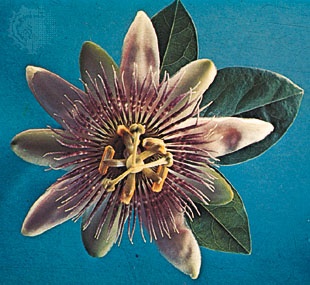Passifloraceae
plant family
 the passion-flower family, in the order Malpighiales, containing 16 genera and 705 species of herbaceous or woody vines, shrubs, and trees, mostly of warm regions. Passifloraceae is most highly developed in the Neotropics and in Africa. The largest genus in the family is Passiflora, the passion-flower genus, with 525 species, many of which are highly prized for their showy, unusual flowers (flower).
the passion-flower family, in the order Malpighiales, containing 16 genera and 705 species of herbaceous or woody vines, shrubs, and trees, mostly of warm regions. Passifloraceae is most highly developed in the Neotropics and in Africa. The largest genus in the family is Passiflora, the passion-flower genus, with 525 species, many of which are highly prized for their showy, unusual flowers (flower).Many members of the family climb by means of tendrils borne in the leaf axil, though others are erect trees or shrubs. The leaves are often spirally arranged along the stem and are stipulate. Other characteristics include the presence of radially symmetrical male, female, or bisexual flowers with three to five sepals, petals, and stamens. The flowers usually have a one-chambered ovary composed of three to five carpels (ovule-bearing segments), with numerous ovules attached to the inner ovary walls. The stamens are below the ovary, and both are usually borne on the end of a stalk called an androgynophore. Sometimes only the ovary is carried on the stalk. Nearly all species have seeds that bear a fleshy appendage called an aril. In the passion-flower family there often are one or more whorls of tendril-like structures, called the corona, in the flower. The fruits are capsules or berries.
Passiflora is most diverse in the Neotropics, with just 20 or so species native elsewhere in the Pacific and Indomalesian region (none occur in Africa). Many Passiflora species are cultivated for either their flowers or their edible fruits, such as the giant granadilla (P. quadrangularis), sweet calabash (P. maliformis), yellow granadilla (P. laurifolia), and purple granadilla (P. edulis). The other large genus in the family is Adenia, with about 100 species found in Africa and tropical Asia. The 35 members of the genus Basananthe are restricted to tropical and southern Africa.
Passifloraceae is part of a cluster of related families that includes Violaceae (Viola) and Salicaceae.
- Ugra, Battle of the
- Uguccione Della Faggiuola
- UHF
- Uhland, Ludwig
- Uhlenbeck, George Eugene
- Uighur
- Uighur language
- Uinta Mountains
- Uintatherium
- Uist
- Uitenhage
- Uitlander
- Uji
- uji
- ujigami
- Ujjain
- Ujung Kulon National Park
- Ukemochi no Kami
- Ukhta
- Ukiah
- ukiyo-e
- Ukko
- Ukraine
- Ukraine, flag of
- Ukrainian Greek Catholic Church